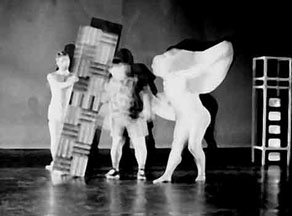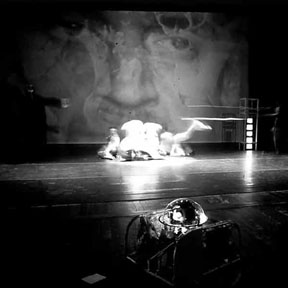
Darwin and The Ship's Detective robot
photo: J. Betancourt
The Talking
Cure in Hypermedia Performance Production
musEleanor, C.M.S.A., interviews
three principal characters from Sayonara Diorama
©Adrianne Wortzel 1999
[published in Performance Research Journal, Volume 4, No. 2, Summer 1999, pp. 89-91]
Sayonara Diorama was a multiple-site, electronic media performance featuring a repertory company of robots and actors, presented by the Lehman College Art Gallery and the Lovinger Theater, 28 March and 4 April, 1998, with funding by the Electronic Media and Film Program of the New York State Council on the Arts. Documentation can be found on the world wide web at http://artnetweb.com/theoricon/diorama.
musEleanor, Certified Muse in the Service of Art, travels through time, dropping in on innovators and advising them on standards for aesthetics, technical proclivities, historical context and philosophical significance. Her home page on the World Wide Web can be found at http://artnetweb.com/projects/ahneed/museintro.html.
Masters Sciapod, Blemye and Panotti, are manifestations of the imaginary races depicted worldwide in manuscripts, maps and sagas. Solinus, a 3rd century cartographer and author first described inhabitants of unknown territories east of the Nile as imaginary monstrous races.

Darwin and The Ship's Detective robot
photo: J. Betancourt
musE: Welcome! Can you describe yourselves to our reading audience?
Sciapod: Well, its hard to not describe ourselves in comparative terms. I suppose I have to say that I have the body of a man but that my body terminates in one huge foot which can extend over my head like a protective shield from sun and rain.

Sciapod,
DaVinci/Kiru, Mr. Panotti
photo: J.
Betancourt
Panotti: I have the perfect body of a man but with two marvelous extensions - my ears are elephantine and form a protective wrap-around shelter for warming my body.
Blemye: My face is centered in my chest, close to my heart, as God intended.

Blemye, the white robot,
and monitors
musEleanor: Can you tell us a bit about the narrative of Sayonara Diorama?
Blemye: Thirty years after the first voyage of the Beagle, Charles Darwin and Captain Fitzroy once more set out to sea. While on board the New Beagle the expression of their intense and opposing views on organized religion rolled over into a turgid boil.
Panotti: The resulting turbulence forces fate from its lair in the earth's core to the underbelly of a volcano. Appalled at the lateness of the hour, the volcano erupts. A vortex forms, causing the shipwreck of the New Beagle.

Darwin, Pandora, Sciapod, Blemye,
Panotti and The Ship's Detective robot
photo: J. Betancourt
Blemye: Darwin finds himself on the shores of an unchartered island inhabited by inexplicable creatures.
Sciapod: [giggles] That's us!
Panotti: And the robots, of course, and Pandora, and DaVinci/Kiru.
Blemye: Darwin see our habitat as his own personal laboratory and begins to scrutinize us. In his process designates us as the 'other' on our own turf.
Sciapod: We in turn begin to examine the examiner and declare that HE is the 'other'.
Panotti: From that point on, we all begin to 'talk out' the issue of who has the best evolutionary adaptations. At first, it is fairly hostile, but then it becomes a natural investigation.
Blemye: The problem becomes more interesting than the solution.
Panotti: Darwin himself is tired of the random first-come, first-served collection process, the bland classifications necessitated when sorting out bits of data, and the disallowance of leaps of faith in the links between the bits of data.
Sciapod: Excuse me?
Blemye: He craves creative work. He wishes to allow for synapses to cross disciplines, for leaps of faith between the facts to have the capacity to form new, less arbitrary, more naturally evolved connections. He wants to indulge in the recognition of inherent significance of clues rendered more in some bits than in others.
Panotti: Our argument becomes a kind of talking cure -- a path in of itself towards a way to free perception from agenda.
musEleanor: Who wins?
Blemye: Well, truthfully, we all do. We all realize that it is only the process that should be celebrated, not the product.
musEleanor: The performance itself becomes a paradigm for ...
Blemye: ..for the celebration of things as they are, in the moment, and the struggle in itself, natural or unnatural, internal or external.
musEleanor: Throughout the centuries you three have appeared in many manuscripts and maps, and, are particularly known for your appearance in the 13th Century Mappa Mundi at Hereford Cathedral . Can you describe the difference in appearing in a live performance in a theater which was also simultaneously visible on the world wide web and appearing in a flat hand-drawn facsimile of the earth's appearance?
Panotti: In both cases we felt we were intricately woven into the tapestry of the world.
musEleanor: There is much talk lately of "hybrid" art, art that encompasses paradigms from various disciplines. Did you feel that Sayonara Diorama, which was a formally scripted production performed in a real space but also transmitted via video-conferencing software over the internet, with responsive performances coming in from overseas and visible in the theater, was such a hybrid work?
Blemye: For obvious reasons, we really have problems with the concept of "hybrid". It is such an artificial construct. i.e.. , it presupposes taking two artificial constructs like "real" and "virtual" and yet inventing another construct on shaky ground. We, for example, are considered "hybrids" of men and animal creatures, but we deserve and demand to be recognized as species in our own right; evolved from equally intelligent biological choices.
Panotti: One of DaVinci/Kiru's lines in the play is 'we juxtapose, therefore we are! But that bipolar approach, an artificial construct where something has to be opposed to something else to be recognized, is extremely tiresome.
Sciapod: But then night and day produce a combinatory effect called "dusk", or "dawn", and they are not artificial constructs, but natural.
Blemye: ..which brings us to the awesome recognition that the mimetic qualities of Aristotelian theater are truly passé; it is also a new day in theater, where we do not have to follow what we perceive as nature's example.
Panotti. yes, well...
musEleanor: How did it feel to re-emerge from history into a live theatrical production on-stage and not just live in a two-dimensional manuscript or map?
Blemye At first we were sure the proscenium would render as just another mappa mundi; a flat representation of the world seen through the eyes of an ideologically trained audience.
Panotti: Then we realized that the audience, whether local or on-line, could not only see us, but they could hear us! And because of the internet connection with reactive performances coming in in response to our performance going out it became an interactive and thoroughly real-time experience.
Panotti: For us the fact that we could be heard probably was as astounding as it was for actors engaged in the 20th century transition in cinema from silent films to talkies.
Sciapod: Yes, yes, we were shown D.W. Griffith's Intolerance and mistook it for the best early web site because it was silent except for superimposed audio and it had four interleaved stories from four different time periods.
musEleanor: did you feel a sense of making history while you were arguing with Darwin on-stage about the issue of 'evolution as progress'?
Blemye: Yes, it was quite a deliverance to have a forum in which to point out the nonsense in thinking of evolution as progressive. Evolution it is so subject to circumstances and circumstances change, and our viewpoint is relative to a time frame which could range from seconds to millennia.
musEleanor: Our word quota is up; thank you all so much for your participation.